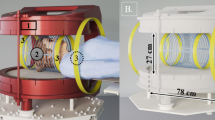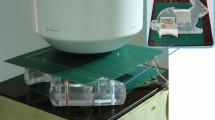Abstract
Three types of magnetic field are used to generate images for magnetic resonance imaging, (MRI):
A strong, constant magnetic field, a gradient magnetic field that can be rapidly switched on and off and a radiofrequency (RF) magnetic field. A typical MRI system therefore consists of three main components that generate these three fields; the main magnet, the gradient coil assembly and the integral rf body transmitter coil. The most common main magnet configurations are superconducting, with a horizontal patient bore. The magnet coils generate a highly uniform magnetic field at the centre of the patient bore which is brought to within a specified limit of homogeneity by a process known as shimming. Three cylindrical copper windings (gradient coils) positioned inside the inner bore of the cryostat each generates a magnetic field gradient which varies the resonant frequency, enabling the MR signal to be encoded in three dimensions. This provides the unique ability to directly acquire cross sectional images in any orthogonal or oblique plane. The integral RF body transmitter coil generates a much smaller magnetic field that oscillates at the resonant (Larmor) frequency, causing the hydrogen nuclei in the patient’s tissue to resonate and then to re-emit the energy, also in the form of an oscillating rf magnetic field. This MR Signal is detected by a RF receiver coil. For Cardiac MRI this is usually a dedicated receiver coil or coil array.
Access provided by Autonomous University of Puebla. Download chapter PDF
Similar content being viewed by others
Keywords
- Magnetic field
- Gradient magnetic field
- Gradient coils
- Radiofrequency magnetic field
- RF
- Patient bore
- Superconducting
- Cryostat
- Liquid helium
- Passive shimming
- Dynamic shimming
- Resonant frequency
- Larmor frequency
- Specific absorption rate
- SAR
- Transmitter coil
- Receiver coil
The use of Magnetic Resonance (MR) in medicine involves the interaction of magnetic fields with biological tissue. For magnetic resonance imaging, (MRI), three types of magnetic field are used to generate images.
-
A strong, constant magnetic field. This has the symbol B o and defines the nominal operating field strength of a particular MRI system. This is measured in units of Tesla, (T) with 1 T equal to approximately 20,000 times the earth’s magnetic field.
-
A gradient magnetic field that can be rapidly switched on and off. This magnetic field has a strength that increases with position along a chosen direction and is measured in units of milliTesla per metre (mT/m).
-
A radiofrequency (RF) magnetic field that oscillates at a characteristic frequency in the Megahertz range, the exact value of which is determined by the nominal field strength of the main magnet. This is given the symbol B 1 .
A typical MRI system therefore consists of three main components that generate these three fields, the main magnet, the gradient coil assembly and the integral radiofrequency body transmitter coil. These are described in the sections that follow which will use the convention of Cartesian axes (x, y, and z) in the directions as shown in Fig. 1.1.
(a) The Key features of superconducting magnet design showing the Cartesian axes with the horizontal z-axis, the static Bo field direction, the patient bore and magnet coils. (b) Internal construction of magnet cryostat. The spherical homogenous volume is indicated by the dotted line. (c) A vertical field, open magnet configuration. The z-axis is vertical for this configuration
The Main Magnet
The most common main magnet configurations are Superconducting, with a Horizontal Patient Bore with field strengths of 1.0 T, 1.5 T, 3.0 T.
Superconducting magnets consist of several circular magnet coils each consisting of many turns of wire (windings) carrying a high electrical current. This generates a strong, constant magnetic field, B o , in a horizontal direction through the centre of the coils (parallel to the z axis as shown in Fig. 1.1a).
The windings are made of a material that becomes superconducting when cooled to liquid helium temperatures (approx. 4 K or −269 °C). They are immersed in liquid helium contained within a vessel (the ‘Cryostat’) surrounded by two vacuum layers to reduce the boil-off rate of the liquid Helium (Fig. 1.1b). The Cryostat has a central bore open at both ends of the magnet (the patient bore).
The magnet coils are positioned to generate a highly uniform magnetic field at the centre of the patient bore typically over a spherical region between 45 and 50 cm in diameter, known as the homogeneous volume. The extent of this region determines the maximum field of view that can be imaged at one time.
The magnetic field is brought to within a specified limit of homogeneity by a process known as shimming. At the time of installation, small pieces of steel are placed around the inside of the magnet bore to modify the magnetic field so that it has the best uniformity within the homogenous volume. This process is known as passive shimming and it takes into account the effect that any steel within the building structure might have. It is also possible to perform active Shimming of the magnetic field by using small magnetic fields generated by additional electromagnetic coils to correct any remaining variations in the magnetic field. This may be done by using either the gradient coils (see next section) or dedicated shim coils. A standard shim is determined at installation to provide the best uniformity over the whole imaging volume. dynamic shimming may also be performed on a scan by scan basis in order to provide the best magnetic field homogeneity over a particular region for specific applications.
Once the magnet has been energised after installation, it remains on at all times. Superconductivity is maintained by minimising the boil-off rate of liquid helium using a cooling system and periodically topping it up. Current systems can maintain sufficient levels of helium for several years before topping up.
Safety Point
As the magnet remains on all the time, (even outside normal working hours), the strong magnetic field presents a constant hazard and safety measures must therefore be applied at all times (See Chap. 2).
Vertical field ‘open’ MR systems are also commercially available, currently having field strengths of up to 1.0 T (Fig. 1.1c). Open MR systems often use magnet designs that are based on permanent magnets or iron cored resistive magnets but these have lower field strengths than superconducting systems.
The Gradient Coil Assembly
This consists of a set of three cylindrical copper windings (gradient coils) positioned inside the inner bore of the cryostat (Fig. 1.2). Each gradient coil generates a magnetic field gradient This is a field applied in the same direction as the main magnetic field that either adds or subtracts in such a way as to create a net total field that varies in strength with position along each of the x, y and z directions (Fig. 1.3). This also varies the resonant frequency and enables the MR signals subsequently emitted to be related to particular locations (see Chap. 6). The use of the three gradients enables the signal to be encoded in three dimensions and provides the unique ability to directly acquire cross sectional images in any orthogonal or oblique plane. The gradient magnetic fields can be independently switched on or off rapidly in less than a millisecond and may be kept on for a few milliseconds at a time. As the fields are switched rapidly within the main magnetic field they cause the gradient coils to vibrate creating the familiar loud banging noise that is associated with MRI systems.
This diagram shows how gradient field of slope Gx is superimposed onto the main magnetic field, Bo to produce a total field that varies in the x direction, B(x). The strength of the magnetic field is represented by the length of the arrows in each case. The direction of each magnetic field is along the z axis but the direction of the gradient (change in strength) is along the x axis
Safety Point
The rapidly switched gradient magnetic fields are only active during image acquisition however they present two additional hazards:
-
The rapidly changing electromagnetic field (often denoted dB/dt) can cause peripheral nerve stimulation of patients.
-
The banging noise is sufficiently loud to warrant the use of hearing protection by patients and carers that remain in the examination room.
The Integral Radiofrequency (RF) Body Transmitter Coil
This consists of a cylindrical copper antenna mounted inside the gradient coil assembly (Fig. 1.2). It generates a much smaller magnetic field, B 1 that oscillates in a direction at right angles to the main magnetic field along the x or y axes. The frequency of oscillation (known as the resonant frequency or Larmor frequency), corresponds to the nominal operating frequency of the MRI system which in turn is determined by the nominal field strength of the main magnetic field. The operating frequency is typically in the Megahertz range (as used by short wave radios) and hence B 1 is known as the radiofrequency (RF) magnetic field. The resonant frequencies for the most common nominal field strengths are given in (Table 1.1):
The RF magnetic field produced by the integral body coil is used to transmit energy into the patient. It is normally delivered in the form of a short pulse, known as a RF pulse (see Chap. 4). When applied at the resonant frequency this causes the hydrogen nuclei in the patient’s tissue to absorb the energy, to resonate and then to re-emit the energy, also in the form of an oscillating RF magnetic field.
Safety Point
The radiofrequency field creates a further hazard as it has the potential to cause heating of body tissue. The rate of energy deposition is characterised by the specific absorption rate (SAR) with units Watts per Kilogram of tissue (W/Kg) and is carefully monitored and controlled.
The Receiver Coil
The oscillating magnetic field (MR Signal) emitted is detected by a RF receiver coil. For cardiac MRI this is usually a dedicated receiver coil or coil array, whose design is tailored to maximise signal detection around the heart and to minimise the detection of ‘noise’ from elsewhere in the body and surrounding environment (see Fig. 1.2). The MR signal is small; the voltage induced in the receiver coil is typically measured in microvolts and so it is very sensitive to interference from external sources of electrical noise. The integral body transmitter can also be used as a receiver coil. Although it is less sensitive than a dedicated receiver coil, it can provide a more uniform detection field which is sometimes advantageous.
Summary
-
Cardiac Magnetic Resonance Imaging uses three types of magnetic field to generate images:
-
A strong constant magnetic field is generated by the main magnet
-
A rapidly switched gradient magnetic field is generated by an assembly of three gradient coils (one for each direction, x, y and z) mounted inside the main magnet
-
A radiofrequency (RF) magnetic field is generated by the integral rf body transmitter coil mounted inside the gradient coil.
-
-
A separate RF receiver coil that is tailored to maximise signal from the heart is normally used to detect the emitted MR signal.
-
Philips www.medical.philips.com
-
Siemens www.healthcare.siemens.com
-
Toshiba www.toshibamedicalsystems.com
Further Reading
McRobbie DW, Moore EA, Graves MJ, Prince MR. Let’s talk technical: MR equipment. In: MRI from picture to proton. 2nd ed. Cambridge: Cambridge University Press; 2007. p. 167–91.
Author information
Authors and Affiliations
Corresponding author
Editor information
Editors and Affiliations
Rights and permissions
Copyright information
© 2015 Springer International Publishing
About this chapter
Cite this chapter
Ridgway, J.P. (2015). What’s Inside the Magnet and Why?. In: Plein, S., Greenwood, J., Ridgway, J. (eds) Cardiovascular MR Manual. Springer, Cham. https://doi.org/10.1007/978-3-319-20940-1_1
Download citation
DOI: https://doi.org/10.1007/978-3-319-20940-1_1
Publisher Name: Springer, Cham
Print ISBN: 978-3-319-20939-5
Online ISBN: 978-3-319-20940-1
eBook Packages: MedicineMedicine (R0)







